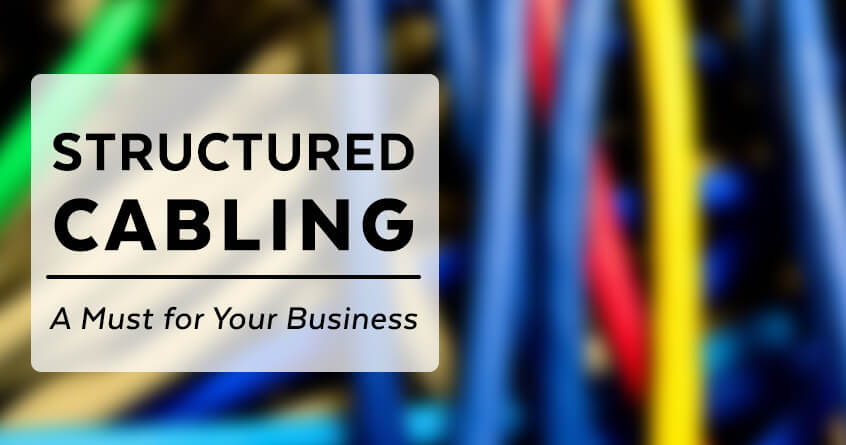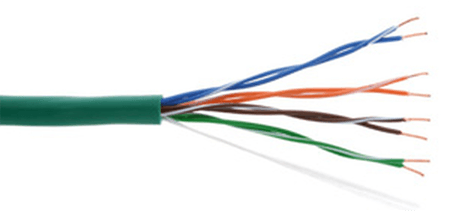All businesses need computers, faxes, phones, printers, scanners, security systems, etc.—and they all need to be connected! And connections require cables—lots and lots of cables.
Undoubtedly, the most vital part of a network administrator’s job is to keep the network up and running smoothly. However, a significant number of these executives have experienced network downtimes due to a low-quality, messy cabling system. Unfortunately, cabling is often overlooked, and a colossal heap of tangled wires in back rooms or even under employee’s feet is all too common. The solution is a structured cabling system.
What Is a Structured Cabling System?
Structured cabling is an infrastructure that controls all network traffic: voice, data, video, and even extensive and complex building management systems. This framework comprises small, standardized blocks that connect to form a high-performance network cabling system. It is important to note that this cabling solution will most likely include racks, network cabinets, hardware ports, and more. In simple terms, cabling and its attendant hardware are organized in a standard way that renders each cable accessible and allows for future changes or additions as needed.
Every Structured Cabling System is Unique
While the technologies used to complete a structured cabling system are fairly standard, each individual design can vary, based on:
- The structure of the office building itself
- The cables, connections, and hardware used
- The configuration of an existing cabling system (for upgrades and retrofits)
- Customer requirements
While each installation can be personalized to a great degree, it is important for the installation process itself to be performed with adherence to certain standards. The U.S. cabling installation and cabling manufacturer industries as a whole embrace the American National Standards Institute (ANSI), the Electronic Industries Alliance (EIA), and the Telecommunications Industry Association (TIA) standards regarding the proper design installation, and maintenance of structured cabling systems.
Structured Cabling Subsystems
When considering a structured cabling solution, you need to realize that the system will not just be confined to a data center. Structured cabling systems actually run throughout a building or even a campus. There are six standardized elements that can make up a structured cabling system; these elements are called “subsystems.” These subsystems will be located throughout the building.
1) Entrance Facilities (EF): This is the physical point where the wiring begins and includes connections between the outside plant and the inside of the building.
2) Equipment Rooms (ER): These are “critical environment” spaces that house equipment or consolidation points (CPs).
3) Backbone Cabling: This cabling provides both “inter” and “intra” connections between access provider spaces, entrance facilities, equipment rooms, and telecommunications rooms.
4) Horizontal Cabling: This cabling extends from the work area to the telecommunications room. In addition to horizontal cabling, it consists of mechanical terminations, jumpers, and patch cords in the telecommunications room.
5) Telecommunications Room (TR): This controlled environment houses telecommunication equipment and connecting hardware, which connects the backbone and horizontal cabling.
6) Work Area (WA) Components: These are the connections between the end user’s equipment and the horizontal cabling system outlets.
Let’s Talk About the Cables
With the use of the six subsystems listed above, the wiring will be accessible when the time comes for a repair or an upgrade.
But what about the cables themselves?
Each cable has a distinct purpose, and they all work together as part of the system. With a structured cable system, standards dictate how the actual line is laid. The upside is that all cables will be neatly placed, labeled, and easy to identify.
Cables can be made of copper or fiber. The type of cables used depends on the needs of the organization.
Commonly Used Cables
1. Twisted Pair Cable
Techopedia defines twisted pair cable as follows:
A twisted pair cable is a type of cable made by putting two separate insulated wires together in a twisted pattern and running them parallel to each other. This type of cable is widely used in different kinds of data and voice infrastructures.
Twisted pair cables use copper wires and come in two types: unshielded twisted pair (UTP) and shielded twisted pair (STP). UTP is commonly used in Ethernet installations, while STP is used to prevent things like electromagnetic interference and crosstalk and helps provide grounding.
2. Coaxial Cable
Coaxial cable (also called coax or radio frequency (RF) cable) is described by TechTarget as follows:
Coaxial cable is a type of copper cable specially built with a metal shield and other components engineered to block signal interference
They are most commonly used for:
- Broadband internet
- Cable TV
- Computer data
- Connecting radio transmitter and receivers to antennas
- Telephone
3. Fiber Optic Cable
Tech Terms defines fiber optic cable as follows:
Fiber optic cable is a high-speed data transmission medium. It contains tiny glass or plastic filaments that carry light beams. Digital data is transmitted through the cable via rapid pulses of light. The receiving end of a fiber optic transmission translates the light pulses into binary values, which can be read by a computer.
Fiber optic cables are used for high-speed connections or long-distance telecommunications between separate buildings on a campus.
Structured Cabling Components
There are three main components of a structured cabling infrastructure.
1. Patch Panels
Patch panels (also called patch bays) are attached to network racks usually housed in communication closets or data centers. They connect cables to a switch.
2. Switches
In cabling, a switch receives, processes, and sends data. It connects patch panels thus enabling devices to connect to the network, share data, and access the internet.
3. Trunk Cables
Trunk cables are an assemblage or gathering of wires bound into one large cable, thus consolidating the wires that run from patch panel to patch panel. Trunk cables keep everything neat and organized.
The Benefits of a Structured Cabling System
Below is a list of five major reasons to consider investing in a structured cabling system:
- Cost effective: Organized cabling systems reduce power costs, maintenance costs, and eliminate the time wasted while trying to locate and correct issues.
- Flexible and scalable: With a structured cabling system, moves, adds, and changes can be quickly and easily handled.
- Future proofing: Structured cabling has the high bandwidth that is a vital component to any company’s growth. This system will not become outdated and will be able to support new applications as a business expands.
- Reduces downtime risk: Messy, disorganized cabling structures lead to high incidents of human error. These mistakes cause work disruption and costly downtime. A well-organized cabling system makes it much easier to identify and fix any problems.
- Simple: Structured cabling systems are pretty straightforward—all office devices and IT equipment run on one single system.
Conclusion
A good structured cabling system is the glue that binds an organization’s computers, phone, printers, and other essential devices together. It is a neat, organized solution to the challenge of “herding” hundreds (maybe even thousands) of cables that are necessary to support a thriving, evolving business environment.
A Few Words About Us
Planet Technology USA maintains a large inventory of standard switches, PoE switches, industrial PoE switches, and cabling. If we can help you with any questions, or if you would like to look at our line of products, contact us by clicking here.



